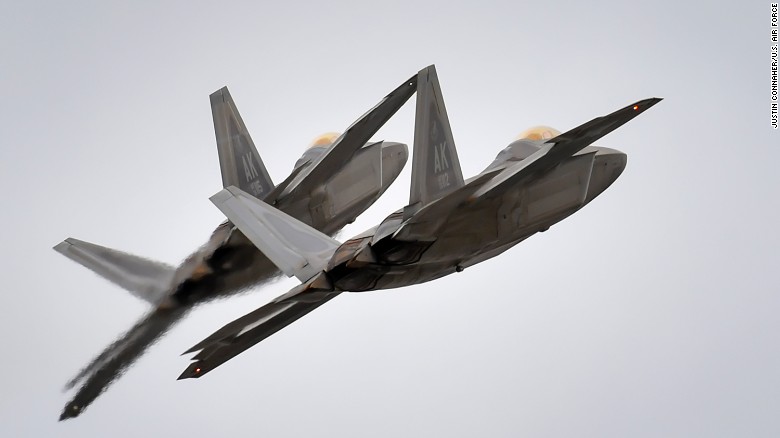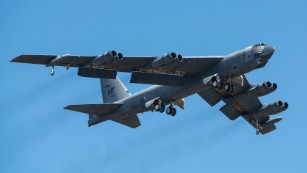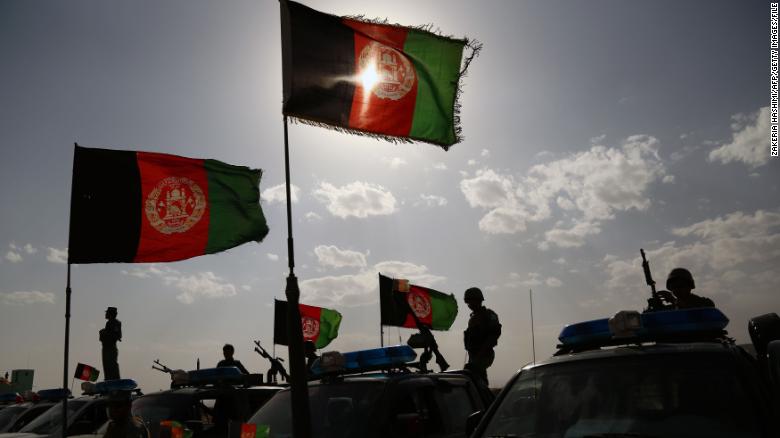US conducts airstrikes on Afghanistan opium labs
(CNN)The US conducted airstrikes targeting opium processing labs in Afghanistan Sunday, Pentagon spokesman Lt. Col. Michael Andrews tells CNN.
The airstrikes were part of a joint US-Afghan operation targeting drug facilities in Taliban-controlled areas in northern Helmand Province.
Three of the strikes occurred in Kajaki district, four in Musa Qala and one in Sangin.
The airstrikes were carried out by US F-16s out of Bagram Air Base in Afghanistan and US B-52s flying out of Al Udeid Air Base in Qatar, Andrews said.
Gen. John Nicholson, the commander of US forces in Afghanistan, told reporters at the Pentagon that a US F-22 Raptor and Afghan Air Force A-29s also participated in the strikes.
Afghan commandos rescue 15 people from Taliban prison
The strikes marked the first use of the F-22 in Afghanistan, according to US officials. The advanced stealth fighter aircraft is based at Al Dhafra Air Base in the United Arab Emirates and required refueling support from KC-10 and KC-135 aircraft to reach the target.
US Air Forces Central Command, which oversees US aircraft in the region, said the US Marine Corps also operated long-range High-Mobility Artillery Rocket Systems in support of the operation.
Nicholson said 10 facilities were hit during the course of the operation, with eight of them struck by US aircraft and two by Afghan warplanes.
PHOTOS: In the U.S. Air Force fleet
A-29 Super Tucano – An A-29 Super Tucano taxis on the flightline during its first arrival, Sept. 26, 2014, at Moody Air Force Base, Georgia. Afghan Air Force pilots trained on the planes that will be used in air-to-ground attack missions in Afghanistan.
Hide Caption
13 of 24
PHOTOS: In the U.S. Air Force fleet
KC-135 Stratotanker – The four-engine KC-135 joined the Air Force fleet in 1956 as both a tanker and cargo jet. It can carry up to 200,000 pounds of fuel and 83,000 pounds of cargo and passengers in a deck above the refueling system. More than 400 of the KC-135s are flown by active, Air Guard and Reserve units.
Hide Caption
14 of 24
PHOTOS: In the U.S. Air Force fleet
F-16 Fighting Falcon – The single-engine jet is a mainstay of the Air Force combat fleet. It can perform both air-to-air and air-to-ground missions with its 20mm cannon and ability to carry missiles and bombs on external pods. More than 1,000 F-16s are in the Air Force inventory.
Hide Caption
15 of 24
PHOTOS: In the U.S. Air Force fleet
AC-130 gunships – The AC-130H Spectre and the AC-130U Spooky gunships are designed for close air support, air interdiction and force protection. Armaments on the Spectre include 40mm and 105mm cannons. The Spooky adds a 25mm Gatling gun.
Hide Caption
16 of 24
PHOTOS: In the U.S. Air Force fleet
C-17 Globemaster transport – The four-engine jet joined the Air Force fleet in 1993 with a primary mission of troop and cargo transport. Each plane can carry up to 102 troops or 170,900 pounds of cargo. The Air Force has 187 C-17s on active duty, 12 in the Air National Guard and 14 in the Reserve.
Hide Caption
17 of 24
PHOTOS: In the U.S. Air Force fleet
C-5 Galaxy transport – The C-5, with a wingspan of 222 feet, a length of 247 feet and a height of 65 feet, is the largest plane in the Air Force inventory and one of the largest aircraft in the world. The first versions of the four-engine jet joined the force in 1970. The Air Force expects to have 52 versions of the latest model, the C-5M, in the fleet by 2017.
Hide Caption
18 of 24
PHOTOS: In the U.S. Air Force fleet
CV-22 Osprey – The Osprey is a tiltrotor aircraft that combines vertical takeoff, hover and landing qualities of a helicopter with the normal flight characteristics of a turboprop aircraft, according to the Air Force. It is used to move troops in and out of operations as well as resupply units in the field. The Air Force has 33 Ospreys in inventory.
Hide Caption
19 of 24
PHOTOS: In the U.S. Air Force fleet
E-3 Sentry AWACS – AWACS stands for airborne warning and control system. This four-engine jet, based on a Boeing 707 platform, monitors and manages battle space with its huge rotating radar dome. The planes have a flight crew of four supporting 13 to 19 specialists and controllers giving direction to units around the battle space. The Air Force has 32 E-3s in inventory.
Hide Caption
20 of 24
PHOTOS: In the U.S. Air Force fleet
KC-10 Extender – Based on the DC-10 passenger jet, the triple-engine KC-10 is a gas station in the sky with the ability to carry 75 people and 170,000 pounds of cargo. In its six tanks, the KC-10 can carry up to 356,000 pounds of fuel and dispense it while airborne. The Air Force has 59 KC-10s on active duty.
Hide Caption
21 of 24
PHOTOS: In the U.S. Air Force fleet
T-38 Talon – The twin-engine jet trainer, used by the Air Force to prepare pilots for the F-15E Strike Eagle, F-15C Eagle, F-16 Fighting Falcon, B-1B Lancer, A-10 Thunderbolt and F-22 Raptor, first flew in 1959. Almost 550 are in the active force.
Hide Caption
22 of 24
PHOTOS: In the U.S. Air Force fleet
U-2 – The single-engine, single-pilot U-2 is used for high-altitude reconnaissance and surveillance. Flying at altitudes around 70,000 feet, pilots must wear pressure suits like those worn by astronauts. The first U-2 was flown in 1955. The planes were used on missions over the Soviet Union during the Cold War, flying too high to be reached by any adversary. The Air Force has 33 U-2s in its active inventory.
Hide Caption
23 of 24
PHOTOS: In the U.S. Air Force fleet
WC-135 Constant Phoenix – The four-engine WC-135 is used to fly through airspace to detect the residue of nuclear blasts. "The aircraft is equipped with external flow-through devices to collect particulates on filter paper and a compressor system for whole air samples collected in holding spheres," the Air Force says. It has two of these jets in the active force.
Hide Caption
24 of 24

PHOTOS: In the U.S. Air Force fleet
F-22 Raptor – The twin-engine F-22 stealth fighter, flown by a single pilot and armed with a 20mm cannon, heat-seeking missiles, radar-guided missiles and radar-guided bombs, can perform both air-to-air and air-to-ground missions. The service has 183 of the Raptors, which went operational in 2005












